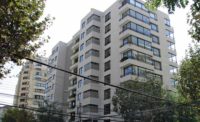Researcher’s Rocking Frame ‘Shakes’ World of Performance-Based Seismic Design
Shattering the stereotype of an ab- sent-minded professor, 20-year academic Gregory G. Deierlein is as focused as any design engineer. In recent years, the director of the John A. Blume Earthquake Engineering Center at Stanford University has concentrated on performance-based seismic design, developing a “rocking frame” intended to give seismic engineers another structural option.
Deierlein’s peers say the licensed engineer is an exceptional researcher, educator and leader in structural engineering. “He couples progressive thinking on innovative structural systems with a strong understanding of practical engineering design,” says Jerome F. Hajjar, a University of Illinois professor of engineering.
Hajjar should know: He is Deierlein’s partner on many projects, including the $1.4-million study “Controlled Rocking of Steel-Framed Buildings With Replaceable Energy-Dissipating Fuses.”
The rocking frame proved itself in performance last year during shake-table tests in Japan. It not only survived extremely strong shaking; it returned to its original plumb position, as intended by design. The test represents a significant step toward a performance-based, build-for-repair approach to seismic design, beyond engineering for only life safety.
Deierlein subjects his research results to the scrutiny of practitioners, so his findings can be implemented. “Greg has a wonderful ability...to create real benefits for the design profession,” says David Mar, principal of Tipping Mar, Structural Engineering in Berkeley, Calif.

Following successful tests on a rocking frame, Deierlein is working on developing a design method so that engineers can use the build-for-repair system.
Deierlein’s practical insights, gained from experience as a design engineer, and his drive to innovate have led to research that has the potential “to revolutionize the industry,” adds design engineer Gregory P. Luth.
Deierlein says he is motivated by the idea that his research can both answer design engineers’ questions and have an impact on design. His next step, with the rocking-frame research, is to develop generalized theories and models that ultimately become design methods. He and Hajjar now will expand the circle of engineers they are talking to about the rocking frame. The goal is for the design methods to become part of codes and standards.
“I enjoy research and delving into problems more deeply than you can do in practice,” says Deierlein. “That said, there are still days I wake up and wonder why I left design.”







